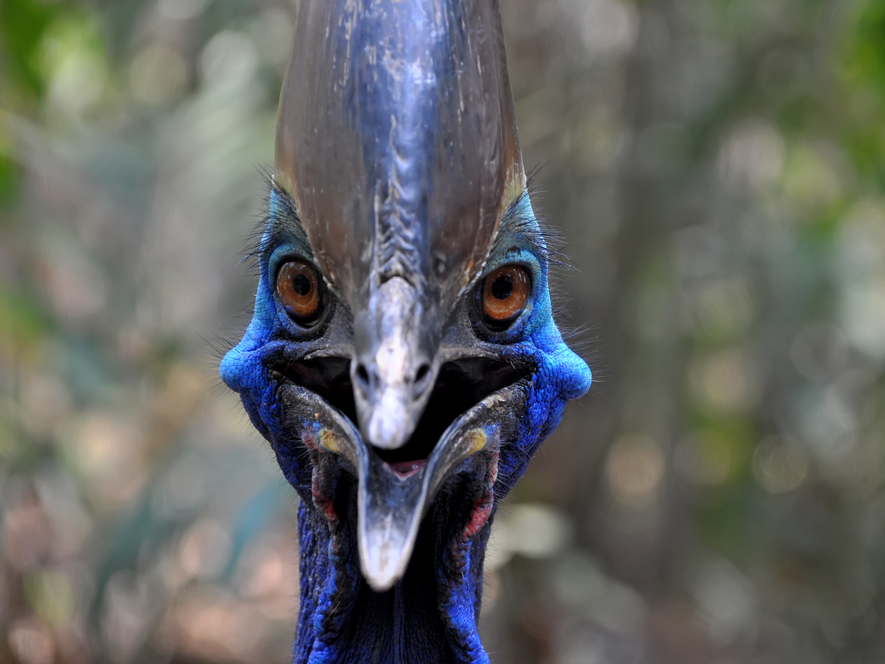- Birds can be beautiful and environmentally helpful but also dangerous and deadly.
- Hawks, owls, and other members of the raptor family are very protective of their young and sometimes can be violent.
- Some species of eagles can carry off large mammals – including antelopes.
- According to Johnny Cash’s autobiography, he was once almost killed by an angry ostrich.
Birds can be beautiful and majestic but sometimes, they can also be terrifying. It’s all about perspective in most cases – after all, as humans, we will feel differently about most raptors than we would if we were mice. The following bird species, however, are large enough and feisty enough to scare even humans.
It’s important to remember that respect is key – you’ll notice that a key component in what angers all of the birds listed below the most is when a person threatens their territory and/or their young.
Here are 10 birds that might scare you.
Every spring in Australia brings magpie swooping season.

Australian magpies aren’t the same as European magpies – they’re a completely different bird. Many other birds engage in swooping behavior, according to experts – it’s just that they’re smaller, so they don’t usually hurt us.
Magpies, though, can cause serious injury - so some Australians have taken to wearing helmets and waving sticks around to keep from being flown into and sustaining head injuries from swooping magpies in September and October, according to CNN.
Hooded pitohuis are secretly dangerous.

They look tiny and unassuming, and even beautiful - but in actuality, their feathers contain a potent toxin that can paralyze and even kill you, according to Australian Geographic.
These gorgeous but deadly creatures regularly feed on melyrid beetles, which is their source for the deadly batrachotoxins with which they become imbued, according to a 2000 paper in the Proceedings of the National Academy of Sciences.
Every winter, there's a noticeable uptick in owl attacks on both dogs and humans.

As cold weather makes other food sources scarce, young owls try to hunt anything they can - including and especially small dogs. Barred and great horned owls are known to divebomb humans who get too close to their nests, as well.
Joggers in wooded areas in Oregon often face the wrath of great barred owls - which are known for dive-bombing humans who have encroached too close to their nests in order to protect their young.
Similarly, hawks don't like it if you get too near their nests.

Depending on where you live, different hawks may be native to your area, and may have slightly different tendencies. But when nesting season is in full swing, many hawks become very aggressive. "We get calls every year about aggressive hawks that are attacking people," Tim Cozine, a veteran wildlife biologist with the USDA's wildlife services told the Hartford-Courant regarding red-shouldered hawk attacks in the Fairfield, Connecticut area.
If you find yourself facing down an angry hawk, the key is to keep facing them - they'll only attack if you turn your back.
Pelicans can swallow their prey whole.

According to National Geographic, it's a brilliant trap for fish - pelicans just catch them in some water, spit out the water, then swallow them whole. Also, they can weigh up to 30 pounds and have a 10-foot wingspan, which is twice as long as any five-foot humans you know.
Shoebill storks don't have a terrifying name but they make terrifying noises and also can decapitate crocodiles with their jaws.

Shoebill storks, which live in the swamps of eastern tropical Africa, are impressively large - often five feet tall - and can decapitate baby crocodiles using only the power of their jaws, according to Audubon. They also make machine gun noises, if that's not enough.
Sea eagles are a protected species in the United Kingdom.

Once nearly extinct, they've been widely considered a conservation success story - but they also have a liking for carrying off live lambs in Scotland, according to farmers there.
The Independent reported at the beginning of 2018 that some farmers were even trialing laser beam systems to protect their sheep from being carried off by the UK's largest bird of prey. The systems don't harm the birds, they just scare them away from the sheep before they can pick them up and fly away. These birds are reportedly large enough that one nickname for them is "flying barn doors."
Martial eagles are Africa's largest eagle.

They're raptors- and they're big and forceful enough to knock a human over. Also, they hunt prey of a larger size than you might expect - baboons, goats, lambs, antelopes, calves, and impala. They also eat other poultry, according to Kruger National Park.
Ostriches can reach nine feet in height.

Ostriches, particularly adults who feel their young are being threatened, can be extremely dangerous if provoked. In 2016, when ostriches were on the loose in a small village in Ayrshire, a spokesperson for the Scottish Society for Prevention of Cruelty to Animals told the Telegraph, "We are warning members of the public not to approach the adult ostrich and to especially avoid approaching its young as ostriches can be very protective and can become extremely aggressive.
Also, they can weigh more than 330 pounds and run up to 45 mph, according to the Encyclopedia Britannica.
Johnny Cash related a story in his autobiography about the time he was almost disemboweled by an angry ostrich - and how if it wasn't for his large, strong belt buckle, he felt sure the ostrich would have succeeded in killing him instead of just breaking five of his ribs.
Cassowaries might be the deadliest living bird on Earth.

Cassowaries, of the same family as ostriches, can't fly but these holdovers from dinosaur days can reach heights of up to five and a half feet and weigh up to 135 pounds. Native to New Guinea and Australia, they can also run at speeds of up to 30 miles per hour, according to Motherboard.
These birds can charge, kick, head-butt, and have three-inch-long incredibly sharp talons with which to disembowel you, according to Scientific American.
The Scientific American reported that a 1999 study by Christopher Kofron of 221 recorded attacks by the bird species showed that attacks are mostly due to an association of humans with food.
Visit INSIDER's homepage for more.

